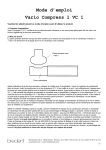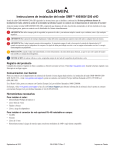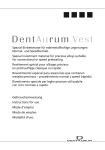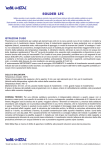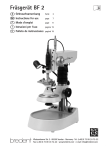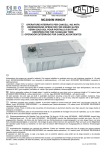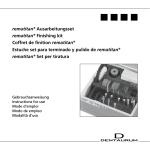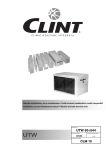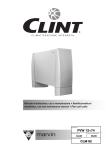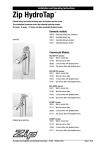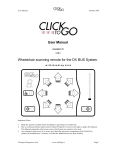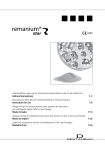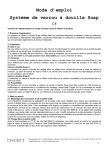Download Vario Compress 1 Vario Compress 2 Vario Compress 1
Transcript
Gebrauchsanweisung Vario Compress 1 Vario Compress 2 D Bitte diese Gebrauchsanweisung vor dem Produkteinsatz ausführlich lesen. Für Schäden, die durch Nichtbeachten dieser Gebrauchsanweisung entstehen, lehnt der Hersteller jede Haftung ab. 1. Produktbeschreibung Vario Compress 1 und Vario Compress 2 sind Halteelemente, welche aus einem Friktionssilikon und einer Stellschraube bestehen. Durch Drehen der Stellschraube wird eine individuelle Friktion erreicht. 2. Indikation Vario Compress 1 und Vario Compress 2 werden im herausnehmbaren Zahnersatz in Verbindung mit teleskopierenden Kronen oder extrakoronalen Stabgeschieben angewendet. 3. Kontraindikation Nach gegenwärtigem Kenntnisstand sind keine Kontraindikationen bekannt. 4. Gefahren- und Sicherheitshinweise Die Lotnummern aller verwendeten Teile müssen zur Gewährleistung der Rückverfolgbarkeit und Reklamationsansprüchen dokumentiert werden. 5. Lagerungs- und Haltbarkeitshinweise 5.1 Lagerung Vario Compress 1 und Vario Compress 2 trocken und staubfrei lagern. 5.2 Haltbarkeit Vario Compress 1 und Vario Compress 2 besitzt keinen festgelegten Haltbarkeitszeitraum. 6. Verarbeitung Die Herstellung der Teleskopkronen oder Geschiebekonstruktionen erfolgt wie gewohnt. Bei Geschiebekonstruktionen generell einen Schubverteiler mit einem parallel gefrästen Interlock herstellen. 6.1 Verarbeitung Vario Compress 1 Vor der Anbringung der VC 1 Keramikschraube muss darauf geachtet werden, dass für die nachfolgende Verarbeitung mit dem Gewindebohrer und Gewindebohrerhandrad ausreichend Platz vorhanden ist. Es empfiehlt sich, vor der Anbringung der VC 1 Keramikschraube die Modellgussmodellation soweit vorzubereiten, dass die VC 1 Keramikschraube zum Schluss in die Modellation integriert werden kann. Die abgeflachte Seite der VC 1 Keramikschraube muss Kontakt mit der Friktionsfläche des Primärteils haben. Es ist darauf zu achten, dass nur die Einkerbung der Keramikschraube Kontakt mit dem Primärteil hat. Der Keramikplatzhalter braucht nicht über die gesamte Länge in der Modellation integriert sein. Der Punkt auf dem Gewinde gibt die maximale Länge (Stellschraube und Friktionspuffer) der ungekürzten Stellschraube Titan an. Das restliche Gewinde und der dickere Teil des Keramikplatzhalters dient als Retention in der Einbettmasse. Den Modellguss nach dem Guss wie gewohnt abstrahlen und auf die Primärkonstruktion aufpassen. Der Keramikplatzhalter darf nicht ausgestrahlt werden, da sonst das vorbereitete Gewinde beschädigt wird. 6.2 Verarbeitung Vario Compress 2 Den VC 2 Keramikplatzhalter so verarbeiten, dass der Gewindeanteil basal oder oral für die spätere Verschraubung zugänglich wird. Wird der Gewindeanteil nach basal gelegt, wird mit der VC 2 Stellschraube „unsichtbar“ von basal aktiviert. Auf dem Einbettmassemodell die Lage des VC 2 Keramikplatzhalters mit einem Stift basal und an der Primärkonstruktion anzeichnen. Mit dem Rapidy Microfräser 2,1 mm (REF H001 NH 21) vorsichtig an der Primärkonstruktion soweit in das Modell einbohren, dass die Rundung des VC 2 Keramikplatzhalters darin versinkt. Anschließend basal in das Modell bohren, bis der Keramikplatzhalter waagrecht zur Primärkonstruktion steht. Den VC 2 Keramikplatzhalter mit Wachs fixieren. Die Modellgussmodellation erfolgt entsprechend der Situation. Den kleinen Stift am VC 2 Keramikplatzhalter nicht auf die gesamte Länge mit Wachs umschwemmen, er dient zur Fixierung des VC 2 Keramikplatzhalters in der Einbettmasse. Die Modellgussmodellation einbetten und gießen. Den Modellguss nach dem Guss wie gewohnt abstrahlen und auf die Primärkonstruktion aufpassen. Der Keramikplatzhalter darf nicht ausgestrahlt werden, da sonst das vorbereitete Gewinde beschädigt wird. 6.3 Entfernen der Keramikschraube Den Keramikentferner nun in das Handstück einspannen und mit niedrigster Umdrehungszahl, jedoch maximal 5000 U/min., in das Gewinde mit leichtem Druck einführen. Es ist darauf zu achten, dass der Keramikentferner nicht verkantet, da sonst die Gefahr besteht, dass er abbricht. Die restliche Keramik mit 50 µ Glanzstrahlperlen entfernen. Den Modellguss auf das Modell aufpassen und polieren. 6.4 Gewinde schneiden Mit dem Rapidy Microfräser 2,3 mm (REF H001 NH 23) eine Fase an der Öffnung des Gewindes anschleifen. Dies erleichtert das Eindrehen der Gewindeschneider. Den Gewinde-Mittelschneider HM in das Gewindebohrerhandrad einspannen. Mit viel Fräs- und Bohröl (REF 550 0000 8) das Gewinde vorschneiden. Das Gewinde nicht auf einmal einschneiden, sondern immer zwei Drehungen nach rechts und eine Drehung nach links, damit die abgeschnittenen Metallspäne vom Gewindeschneider abgleiten können. Wenn das Eindrehen des Gewindeschneiders schwerer geht, ist das vorgeformte Gewinde zu Ende. Nicht mehr weiterdrehen, da sonst der Gewindeschneider abbrechen kann. 6.5 Fertigstellung Die distale Öffnung des kleinen Stiftes und die Gewindeöffnung mit einem Tropfen Wachs schließen und den Modellguss fertigstellen. Nach der Fertigstellung das Wachs entfernen. 6.6 Platzierung des Friktionssilikons Das Vario Compress 1 oder Vario Compress 2 Friktionssilikon (beim Vario Compress 1 mit der geöffneten Seite zuerst) mit einer Pinzette in die Öffnung zum Geschiebe oder Teleskop einführen. Ist das Friktionssilikon zu lang, mit einem Skalpell den Überschuss entfernen. Anschließend die Stellschraube Titan in das Gewinde eindrehen und kürzen. Die Stellschraube Titan kann um 50 % gekürzt werden. Der Dorn an der Vario Compress 2 Stellschraube Titan darf nicht entfernt werden, er dient zur Fixierung des Friktionselements. Durch Drehen der Stellschraube Titan wird das Fritkionssilikon komprimiert, zu der Öffnung zum Geschiebe oder Teleskop herausgedrückt und somit kann die Friktion individuell eingestellt werden. 7. Technische Daten Stellschraube: Titan Friktionssilikon: Spezialsilikon Kürzbarkeit: Die Stellschrauben Titan sind um 50 % kürzbar GB Before using the product, please read these instructions for use carefully. The manufacturer will not accept any liability for damage resulting from non-compliance with these instructions for use. 1. Description of the product Vario Compress 1 and Vario Compress 2 are retention elements, which consist of friction silicon and an adjusting screw. Individual friction is achieved by turning the adjusting screw. 2. Indication Vario Compress 1 and Vario Compress 2 are used in removable restorations in combination with telescopic crowns or extracoronal rod attachments. 3. Contraindication Based on the current state of knowledge there are no known contraindications. 4. Hazard and safety information The lot numbers of all components should be recorded to ensure traceability and to handle complaints. 5. Storage and durability 5.1 Storage Vario Compress 1 and Vario Compress 2 should be stored under dry and dust-free conditions. 5.2 Durability Vario Compress 1 and Vario Compress 2 do not have a specified shelf life. Weissenhorner Str. 2 · 89250 Senden · Germany Tel. (+49) 0 73 09 / 8 72-22 · Fax (+49) 0 73 09 / 8 72-24 www.bredent.com · e-mail [email protected] titanium special silicon the titanium adjusting screws can be shortened by 50 % 8. Symbols Lot number 9. Additional information These instructions for use are based on state-of-the-art methods and equipment and our own experience. The product may only be used for the indication described under item 2. The user himself is responsible for processing the product. Liability for incorrect results shall be excluded since the manufacturer does not have any influence on further processing. Any occurring claims for damages may only be made up to the value of our products. Mode d‘emploi Vario Compress 1 Vario Compress 2 F Veuillez lire attentivement ce mode d’emploi avant utilisation. Le fabricant décline toute responsabilité pour tout dommage qui résulterait de la non observation de ce mode d’emploi. 1. Description du produit Vario Compress 1 et Vario Compress 2 sont des éléments de rétention composés d’un silicone fricatif et d’une vis de réglage. En tournant la vis de réglage on obtient une friction personnalisée. 2. Indications On utilise Vario Compress 1 et Vario Compress 2 pour des prothèses adjointes en présence de couronnes télescopes ou d’attachements tubulaires extra-coronaires. Selon nos connaissances actuelles, des contre-indications ne sont pas connues. 9. Sonstige Hinweise Diese Gebrauchsanweisung entspricht dem aktuellen Stand der Technik und unseren eigenen Erfahrungen. Das Produkt darf nur in der unter Punkt 2 beschriebenen Indikation verwendet werden. Der Anwender ist für den Einsatz des Produktes selbst verantwortlich. Für fehlerhafte Ergebnisse wird nicht gehaftet, da der Hersteller keinen Einfluss auf die Verarbeitung hat. Eventuell dennoch auftretende Schadenersatzansprüche beziehen sich ausschließlich auf den Warenwert unserer Produkte. Vario Compress 1 Vario Compress 2 7. Technical data Adjusting screw: Friction silicon: Reduction of length: 3. Contre-indications 8. Verwendete Symbole Chargenbezeichnung Instructions for use 6. Processing Telescopic crowns or attachment constructions are prepared in the usual way. Attachment constructions always require a shear distributor with a parallel milled interlock. Duplicate the model in the usual way and prepare the investment model. 6.1 Processing - Vario Compress 1 Prior to attaching the VC1 ceramic screw, it must be ensured that there is sufficient space for subsequent processing with the tap and the tap handwheel. It is recommended to prepare the CoCr model (structure) prior to attaching the VC1 ceramic screw so that the VC1 ceramic screw can be finally integrated into the model (structure). The flat side of the VC 1 ceramic screw must have contact with the friction surface of the primary element. It must be ensured that only the notch of the ceramic screw has contact with the primary element. The ceramic spacer does not have to be integrated in the model (structure) across its total length. The dot on the thread indicates the maximum length (adjusting screw and friction buffer) of the titanium adjusting screw that has not been shortened. The remaining part of the thread and the thicker part of the ceramic spacer serve for retention in the investment material. After casting, sandblast the CoCr object in the usual way and fit it on the primary construction. The ceramic spacer must not be sandblasted to avoid damaging the prepared thread. 6.2 Processing - Vario Compress 2 The ceramic spacer of VC 2 must be processed so that access to the threaded area is possible from the basal or oral area to ensure connection with a screw later on. If the thread area is directed to the basal area, “invisible” activation is carried out with the VC 2 adjusting screw from the basal area. Mark the position of the VC 2 ceramic spacer on the base of the investment model and on the primary construction using a pen. Using the Rapidy Microbur 2.1 mm REF H001 NH 21, drill carefully into the model (at the primary construction) until the round area of the VC 2 ceramic spacer is no longer visible. Then drill into the base of the model until the ceramic spacer is aligned horizontally with the primary construction. The VC 2 ceramic spacer is fixed with wax. The CoCr model is waxed up according to the situation. Do not apply wax across the total length of the small pin at the VC 2 ceramic spacer; it serves to fix the VC 2 ceramic spacer in the investment material. Invest and cast the chrome cobalt model. After casting, sandblast the CoCr object in the usual way and fit it on the primary construction. The ceramic spacer must not be sandblasted to avoid damaging the prepared thread. 6.3 Removing the ceramic screw Clamp the ceramic removing tool into the handpiece and insert it into the thread at lowest possible speed (not above 5000 rpm) while exerting slight pressure. The ceramic removing tool must not be tilted to avoid the risk of breakage. The residual ceramic material is removed with abrasive beads (50 µ). The chrome cobalt structure is fitted on the model and polished. 6.4 Tapping Prepare a bevel at the opening of the thread using the Rapidy Microbur 2.3 mm REF H001 NH 23 to simplify turning of the taps. Clamp the second tap HM into the tap handwheel. Precut the thread using sufficient quantities of milling and drilling oil REF 550 0000 8. Do not cut the thread in a single step but always turn the tap two turns to the right and one turn to the left to ensure that cut-off metal chips are removed from the tap. If turning in the tap becomes more difficult, the end of the preshaped thread is reached. Turning must not be continued to avoid breakage of the tap. 6.5 Completion The distal opening of the small pin and the thread opening are sealed with a drop of wax and the chrome cobalt object is completed. The wax is removed after completion. 6.6 Placement of the friction silicon Insert the Vario Compress 1 or Vario Compress 2 friction silicon into the opening towards the attachment or the telescope using tweezers (with the open side first when using Vario Compress 1). A scalpel can be used to cut the friction silicon if it is too long. Then turn the titanium adjusting screw into the thread and shorten it. The titanium adjusting screw can be shortened by 50 %. The pin of the Vario Compress 2 titanium adjusting screw must not be removed since it serves to fix the friction silicon. The friction silicon is compressed by turning the titanium adjusting screw or pressed out of the opening towards the attachment or telescope; as a result, the friction can be adjusted individually. 4. Dangers et consignes de sécurité Les numéros des lots de toutes les pièces utilisées sont à documenter pour assurer la traçabilité en cas de réclamations. 5. Consignes de stockage et date de péremption 5.1 Stockage Stocker Vario Compress 1 et Vario Compress 2 au sec et à l’abri de la poussière. 5.2 Date de péremption Vario Compress 1 et Vario Compress 2 n’ont pas de date de péremption déterminée. 6. Mise en œuvre Les couronnes télescopes ou les infrastructures à attachement se font comme d’habitude. Pour les infrastructures à attachement, réaliser généralement un répartiteur de poussées avec un Interlock à fraisage parallèle. Procéder à la duplication du modèle comme de coutume et réaliser le modèle en matériau de revêtement. 6.1 Mise en œuvre de Vario Compress 1 Avant de fixer la vis céramique VC 1, il faut veiller à ce qu’il y ait suffisamment de place pour l’étape suivante de mise en œuvre avec la taraudeuse et la molette de la taraudeuse. Avant la mise en place de la vis en céramique VC 1, nous recommandons de préparer la maquette du châssis métallique de sorte que la vis en céramique VC 1 puisse être intégrée à la fin dans la maquette. Le côté aplati de la vis en céramique VC 1 doit être en contact avec la surface fricative de la partie primaire. Il faut veiller à ce qu’uniquement l’encoche de la vis en céramique soit en contact avec la partie primaire. L’entretoise en céramique n’a pas besoin d’être intégrée sur toute la longueur de la maquette. Le point sur le taraud indique la longueur maximale (vis de réglage et amortisseur de friction) de la vis de réglage en titane non raccourcie. Le reste du taraud et la partie la plus épaisse de l’entretoise en céramique servent de rétention dans le matériau de revêtement. Sabler le châssis métallique comme de coutume après la coulée et l’adapter sur la construction primaire. Ne pas sabler l’entretoise en céramique, car le sablage pourrait endommager le taraudage qui a été préparé. 6.2 Mise en œuvre de Vario Compress 2 Mettre l’entretoise en céramique VC 2 en place de telle sorte que le taraudage soit accessible de la face basale ou orale pour le vissage ultérieur. Si la partie taraudée est d’orientation basale, on active avec la vis de réglage VC 2 de façon « invisible » de la face basale. Marquer avec un crayon la situation basale de l’entretoise VC 2 sur le modèle en revêtement et sur la construction primaire. Avec une micro-fraise Rapidy 2,1 mm REF H001 NH 21 forer prudemment la construction primaire sur le modèle de sorte que la partie arrondie de l’entretoise en céramique VC 2 s’y enfonce. Ensuite forer dans le modèle à partir de la face basale jusqu’à ce que l’entretoise en céramique soit horizontale par rapport à la construction primaire. Fixer l’entretoise en céramique VC 2 avec de la cire. La sculpture de la maquette du châssis métallique est à réaliser selon la situation. Ne pas entourer le petit tenon de l’entretoise en céramique VC 2 de cire sur toute sa longueur, il sert à la fixation de l’entretoise en céramique VC 2 dans le matériau de revêtement. Mettre la sculpture de la maquette du châssis en revêtement et procéder à la coulée Sabler le châssis métallique comme de coutume après la coulée et l’adapter sur la construction primaire. Ne pas sabler l’entretoise en céramique car le sablage pourrait endommager le taraudage qui a été préparé. 6.3 Retirer la vis en céramique Monter la fraise à céramique dans la pièce à main et l’introduire dans le taraudage à faible vitesse, maximum 5000 t/min. en exerçant une légère pression. Il faut veiller à ce que la fraise à céramique ne gauchisse pas, sinon elle risquerait de se fracturer. Enlever la céramique restante avec des billes de verre de 50 µ. Adapter le châssis métallique sur le modèle et polir. 6.4 Taraudage A l’aide de la micro-fraise Rapidy 2,3 mm REF H001 NH 23, meuler un chanfrein dans l’ouverture du taraud. Ceci facilite l’introduction de l’instrument à tarauder. Monter l’instrument à tarauder moyen en carbure de tungstène dans la molette de taraud. Pré-tarauder le taraud avec beaucoup d’huile de fraisage et de forage, REF 550 0000 8. Ne pas tarauder en une fois, mais toujours procéder avec deux tours vers la droite et un tour vers la gauche, de sorte que les copeaux coupés par l’instrument à tarauder puissent être évacués. Quand l’introduction du taraud devient plus difficile, le taraud préformé est terminé. Ne pas continuer à visser, sinon l’instrument à tarauder pourrait se fracturer. 6.5 Terminer le travail Fermer l’ouverture distale du petit tenon et l’ouverture du taraud avec une goutte de cire et terminer le châssis. Après avoir terminé, enlever la cire. 6.6 Mise en place du silicone fricatif Introduire le silicone fricatif Vario Compress 1 ou Vario Compress 2 (pour le Vario Compress 1 avec le côté ouvert d’abord) dans l’ouverture vers l’attachement ou le télescope à l’aide d’une précelle. Si le silicone fricatif est trop long, enlever l’excédent avec un scalpel. Ensuite visser la vis de réglage en titane dans le taraud et raccourcir. On peut réduire la vis de réglage en titane de 50 %. Ne pas enlever le téton de la vis de réglage Vario Compress 2, il sert à la fixation du silicone fricatif. En vissant la vis de réglage en titane le silicone fricatif sera comprimé et poussé vers l’ouverture vers l’attachement ou hors du télescope et ainsi la friction se laisse régler de façon personnalisée. 7. Dati Tecnici Vite di attivazione: Cilindretto siliconico: Accorciabilità: 7. Données techniques Vis de réglage: Titane Silicone fricatif: Silicone spécial Travail de raccourcissement: On peut raccourcir les vis de réglage en titane de 50 % Vario Compress 2 I Vario Compress 2 Leggere attentamente le istruzioni d’uso prima dell’utilizzo del prodotto. Il produttore non si assume alcuna responsabilità per danni, dovuti all’inosservanza delle presenti istruzioni d’uso. 1. Descrizione del prodotto Vario Compress 1 e Vario Compress 2 sono elementi di tenuta, e sono composti da un cilindretto siliconico e da una vite di attivazione. Ruotando la vite di attivazione si ottiene una frizione individuale. 2. Indicazioni Vario Compress 1 e Vario Compress 2 vengono utilizzati per la protesi rimovibile in combinazione con corone telescopiche o con attacchi a frizione extracoronali. 3. Controindicazioni In base alle nostre conoscenze attuali, non sono note controindicazioni. 4. Avvertenze dei pericoli e per la sicurezza I numeri di lotto di tutti i componenti utilizzati devono essere conservati e documentati a garanzia della rintracciabilità del prodotto ed in caso di reclamo. 5. Avvertenze per la conservazione e la durata 5.1 Conservazione Conservare Vario Compress 1 e Vario Compress 2 in un luogo asciutto e privo di polveri. 5.2 Durata Vario Compress 1 e Vario Compress 2 non hanno una data precisa di scadenza. 6. Lavorazione La realizzazione di corone telescopiche o di costruzioni con attacchi avviene come di consueto. Nel caso di costruzioni con attacchi viene realizzato un fresaggio parallelo con interlock o con due coulisse contrapposte. Duplicare il modello come di consueto e colare il modello con la massa da rivestimento. 6.1 Lavorazione di Vario Compress 1 Prima di applicare la vite in ceramica VC 1 fare attenzione che vi sia spazio sufficiente per la lavorazione successiva con l’alesatore ed il mandrino filettatore. Prima dell’applicazione della vite in ceramica VC 1 si consiglia di preparare la modellazione dello scheletrato, in modo che alla fine la vite in ceramica possa essere integrata nella modellazione. La parte piatta della vite in ceramica VC 1 deve essere a contatto con la superficie di frizione della corona primaria. Fare attenzione che solo la parte incava della vite sia a contatto con la corona primaria. Non è necessario che il mantenitore di spazio sia integrato sulla lunghezza totale della modellazione. Il punto sulla filettatura indica la lunghezza massima (vite di attivazione e cilindretto siliconico) della vite di attivazione in titanio. Il resto della filettatura e la parte più grossa del mantenitore di spazio in ceramica serve per creare nel cilindro una ritenzione sicura con il rivestimento. Dopo la fusione sabbiare lo scheletrato come di consueto ed adattarlo alla costruzione primaria. Il mantenitore di spazio in ceramica non deve essere sabbiato, poiché altrimenti la parte filettata viene danneggiata. 6.2 Lavorazione di Vario Compress 2 Applicare il mantenitore di spazio in ceramica in modo da poter poi montare la vite d’attivazione nella zona basale oppure linguale o palatale. Se la filettatura viene posta nella zona basale, l’attivazione con la vite d’attivazione VC 2 risulta “invisibile”. Con una matita segnare sul modello in rivestimento la posizione del mantenitore di spazio in ceramica VC 2 nella zona basale e sulla costruzione primaria. Con la microfresa Rapidy da 2,1 mm (REF H001 NH 21) realizzare con cautela una concavità nel modello in corrispondenza della corona primaria fino a inserire la parte arrotondata del mantenitore di spazio in ceramica VC 2. Poi praticare un foro basale per il corretto posizionamento nel modello del mantenitore di spazio in ceramica parallelamente alla corona primaria. Fissare con cera il mantenitore di spazio in ceramica VC 2. Completare la modellazione in cera dello scheletrato in base alla situazione. Non integrare completamente nella modellazione in cera il piccolo perno del mantenitore di spazio in ceramica VC 2, poichè serve per fissare il mantenitore di spazio in ceramica nel rivestimento. Segue la messa in rivestimento e la fusione del modellato in cera. Dopo la fusione, sabbiare lo scheletrato come di consueto ed adattare alla costruzione primaria. Il mantenitore di spazio in ceramica non deve essere sabbiato, poiché altrimenti la parte filettata viene danneggiata. 6.3 Rimozione della vite in ceramica Serrare lo scalpello all’interno del manipolo e con un bassissimo numero di giri – massimo 5000 giri/min.– rimuovere la ceramica dalla filettatura, esercitando una leggera pressione. Fare attenzione che lo scalpello non si inclini, poiché altrimenti potrebbe spezzarsi. Eliminare la ceramica rimanente con le perle da lucidatura da 50 µ. Calzare lo scheletrato sul modello e lucidarlo. 6.4 Realizzazione della filettatura Con la microfresa Rapidy da 2,3 mm REF H001 NH 23 creare un invito all’inizio della filettatura, per facilitare l’avvitamento dell’alesatore. Serrare l’alesatore intermedio HM nel mandrino filettatore. Con abbondante olio per fresaggio REF 550 0000 8 realizzare la prefilettatura. Non praticare la filettatura in un’unica fase, ma sempre con due rotazioni verso destra e una a sinistra, in modo da far scivolare via i trucioli metallici dall’alesatore. Nel momento in cui si incontra una certa resistenza ad avvitare l’alesatore, la prefilettatura è terminata. Non continuare ad avvitare, per non rompere l’alesatore. 6.5 Ultimazione Sigillare l’apertura distale del piccolo perno e l’invito della filettatura con una goccia di cera e completare lo scheletrato. Rimuovere la cera a scheletrato ultimato. 6.6 Posizionamento del cilindretto siliconico Con una pinzetta introdurre il cilindretto siliconico Vario Compress 1 o Vario Compress 2 (nel caso di Vario Compress 1 prima con la parte aperta) all’interno del foro per l’attacco o la telescopica. Se il cilindretto siliconico è troppo lungo, rimuovere l’eccedenza con uno scalpello. Avvitare poi la vite di attivazione in titanio all’interno della filettatura e accorciarla. La vite di attivazione in titanio può essere accorciata per circa il 50 %. Il perno sulla vite di attivazione in titanio Vario Compress 2 non deve essere rimosso, in quanto serve per il fissaggio del cilindretto siliconico. Ruotando la vite di attivazione in titanio, il cilindretto in silicone viene compresso e premuto in direzione del foro verso l’attacco o la telescopica, permettendo in tal modo una regolazione individuale della frizione. Weissenhorner Str. 2 · 89250 Senden · Germany Tel. (+49) 0 73 09 / 8 72-22 · Fax (+49) 0 73 09 / 8 72-24 www.bredent.com · e-mail [email protected] 9. Ulteriori avvertenze Questi istruzioni per l’uso si basano sullo stato attuale della tecnica e delle nostre esperienze. Il prodotto deve essere utilizzato solo in base alle indicazioni descritte al punto 2. L’utente è personalmente responsabile dell’utilizzo del prodotto. Il produttore non si assume responsabilità per risultati non conformi, poiché non ha alcuna influenza sulle lavorazioni successive. Nel caso in cui, tuttavia, fosse richiesto un risarcimento dei danni, questo sarà commisurato esclusivamente al valore commerciale dei nostri prodotti. Hoja de instrucciones Vario Compress 1 E 1. Descripción de producto Vario Compress 1 y Vario Compress 2 son elementos de retención que constan de una silicona de fricción y un tornillos de fijación. Por medio de enroscar el tornillo de puede ajustar individualmente la fricción. 2. Indicaciones Vario Compress 1 y Vario Compress 2 se utilizarán en combinación con trabajos removibles con coronas telescópicas o estructuras con barra extra oral. 3. Contraindicaciones Según los últimos estudios, no se conoce ninguna contraindicación. 4. Consejos de peligrosidad y seguridad todos los números de lote de las piezas utilizadas se deberán documentar para poder garantizar su trazabilidad y poder así tener derecho a realizar una reclamación. 5. Consejos de almacenamiento y durabilidad 5.1 Almacenamiento Vario Compress 1 y Vario Compress 2 se deberá almacenar en sitio seco y fuera de polvo. 5.2 Durabilidad Vario Compress 1 y Vario Compress 2 no tiene fecha de durabilidad concreta. 6. Modo de empleo La creación de las telescópicas partes primarias para ataches se realizarán como de costumbre. En construcciones en combinación con atache se deberá realizar un estabilizador (contra fresado) con Interlock paralelo. Preparar el modelo para duplicar y crear el modelo de revestimiento como de costumbre. 6.1 Manipulación del Vario Compress 1 Antes de colocar la rosca de cerámica VC1 hay que tener en cuenta el espacio necesario para el soporte del macho de terraja. Para ello hay que comprobar antes de realizar el esquelético que haya espacio suficiente para la rosca de cerámica VC1 y se pueda integrar la rosca definitiva sin problemas. La zona plana de la rosca de cerámica VC1 deberá tener contacto con la superficie de fricción de la parte primaria. Hay que controlar que la hendidura de la rosca de cerámica tenga contacto con la parte primaria. La rosca de cerámica no tiene por que integrarse por completo en el modelado del esquelético. El punto creado en la rosca indica el largo mínimo que tiene que tener el tornillo (tornillo variable y espacio de amortiguación) de titanio. La parte restante de la rosca de cerámica y la parte más ancha sirven como retención en el revestimiento. Arenar como de costumbre el esquelético y ajustarlo sobre la estructura primaria. El mantenedor de cerámica no se deberá arenar, ya que se podría estropear la rosca interna creada. 6.2 Manipulación del Vario Compress 2 Colocar el mantenedor de cerámica de tal manera, que posteriormente se pueda colocar el tornillo por abajo ó por arriba. Si se coloca por la parte de abajo, el tornillo será invisible, al ser activado. Colocar de tal manera el mantenedor de espacio de cerámica VC 2, que luego sea accesible y cómodo el colocar el tornillo de fricción posteriormente. Marcar con lápiz la posición del mantenedor de cerámica sobre el modelo de revestimiento sobre la cresa alveolar y también en la parte primaria de la corona. Con la ayuda del una fresa Rapidy 2,1 mm (REF H001 NH 21) crear en la parte primaria del modelo una hendidura de tal manera que entre la parte redonda del mantenedor de cerámica VC 2 totalmente. A continuación perforar en el modelo un agujero, hasta que el mantenedor de cerámica VC2 este horizontal a la parte primaria. Fijar el mantenedor de cerámica VC 2 con cera al modelo. A continuación se realizará el modelado del esquelético según se haya planificado anteriormente. El pequeño lápiz del mantenedor de cerámica VC 2 no habrá que envolver de completo en cera, ya que esta creado para mantener al mantenedor de cerámica VC 2 en el cilindro de revestimiento en su sitio correcto. Revestir el modelo y colar. Repasar y pulir la estructura del esquelético como de costumbre y ajustarla sobre la estructura primaria. El mantenedor de cerámica no se puede arenar, ya que se puede dañar la rosca prefabricadas.. 6.3 Retirada del tornillo de cerámica Introducir en la pieza de mano el instrumento para retirar cerámica y a bajas revoluciones como máx. 5000rev/min y con ligera presión retirar la cerámica de la rosca.. A tener en cuenta no trabar el instrumento para retirar cerámica, ya que se puede romper. Los posibles restos que queden retirarlas con perlas de brillo de 50 µ. Ajustar el modo y pulirlo como de costumbre. 6.4 Creación de la rosca Con la fresa Rapidy 2,3 mm (Nºde Ref: H001 NH 23) realizar una hendidura en la apertura de la rosca agilizando así la entrada del macho de terraja. Introducir el macho de terraja medio en la rueda de soporte y con abundante aceite de fresado y perforación (REF 550 0000 8) realizar la rosca. No realizar la rosca de una sola vez, sino realizar siempre dos vueltas a la derecha y una hacia la izquierda, para que la viruta cortada pueda salir de la rosca. Cuando cuesta realizar las vueltas con el macho de terraja se habrá conseguido realizarla por completo. No seguir enroscando, ya que se podrá romper el macho de terraja. 6.5 Terminación La apertura distal del pequeño lápiz y la apertura de la rosca se tapará con una gota de cera y terminar así el esquelético. Una vez se ha terminado el montaje se retira la cera. 6.6 Posicionamiento de la silicona de fricción La silicona de fricción del Vario Compress 1 o Vario Compress 2 (en el Vario Compress 1 con la apertura primero) se colocará con ayuda de una pinza en la apertura hacia el atache o telescópica. Si la silicona de fricción fuese demasiada larga, se recomienda cortarla con un cúter y enroscar el tornillo de titanio y recórtalo continuación. El tornillo de titanio se podrá recortar un 50%. El pincho en el tornillo de titanio del Vario Compress 2 no se puede quitar, ya que sirve para la fijación de la silicona de fricción. Una vez que se enrosque el tornillo de titanio se presiona sobre la silicona de fricción y asomará hacia la apertura del atache o telescópicas, consiguiendo así la fricción individual que se requiera. 7. Datos técnicos Tornillo: Silicona de fricción: Recortable: Titanio Silicona especial El tornillo de titanio se podrá recortar hasta un 50 %. 8. Símbolos utilizados Descripción de Lote 9. Consejos adicionales La información sobre el producto se acoge a los últimos resultados y experiencias sobre el mismo. El producto solo se podrá utilizar como se describe en el punto2. y sus indicaciones. Por ello aconsejamos antes de su uso leer de nuevo la información sobre el producto. Todos los consejos con respecto a su manipulación se basan en nuestra propia experiencia y solo se podrá ver como información orientativa. Nuestros productos están constantemente a desarrollo. Nos reservamos el derecho de cualquier cambio en su construcción y composición. 009828EX-20130625 Désignation du lot 9. Divers Ce mode d’emploi est basé sur les connaissances techniques actuelles et sur nos propres expériences. Le produit doit uniquement être utilisé selon l’indication décrite au paragraphe 2. L’utilisateur est lui-même responsable de l’utilisation du produit. N’ayant aucune influence sur sa mise en œuvre, le fabricant ne saurait être tenu responsable de résultats défectueux ou non satisfaisants. Toute indemnisation éventuelle se limitera à la valeur du produit. Vario Compress 1 8. Simboli utilizzati Numero di lotto Rogamos lean detenidamente la información de producto ante de su uso. Por daños producidos por no tener en cuenta esta hoja de instrucción, no se hace responsable el fabricante. 8. Symboles utilisés Istruzioni d‘uso titanio silicone speciale le viti di attivazione in titanio possono essere accorciate per il 50 %


